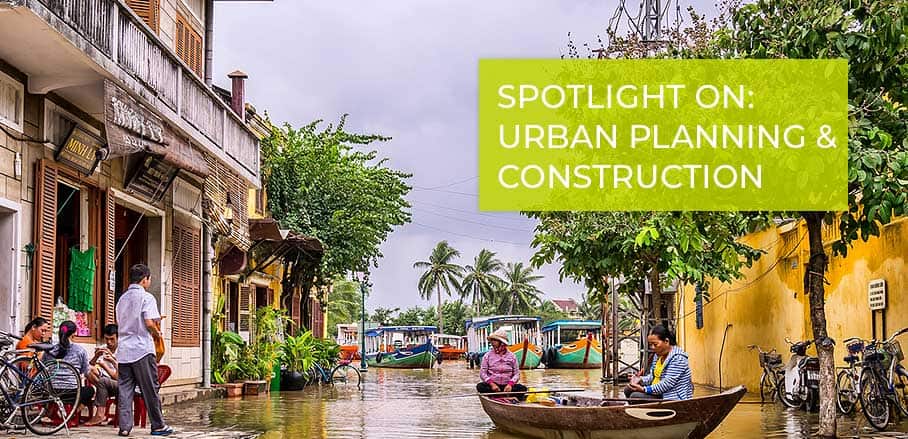How Can Urban Flood Management in Vietnam Become More Sustainable?
More than one third of Vietnam’s population is living in cities, requiring effective sanitation and stormwater services. Yet their provision is limited, with an estimation of less than 10 per cent of wastewater being treated in urban areas. Sebastian Malter argues that a diversification of drainage systems will support sustainable urban development.
Vietnam’s Unique Characteristics
Vietnam is a beautiful country with unique climatological and topographical characteristics, featuring 3,260 kilometres of coastal lines, two plane areas, and mountainous regions. This topography in combination with the tropical monsoon climate puts the country at high risk for natural disasters.
Between 1954 and 1999, about 212 typhoons landed in or directly influenced the country, causing pollution, breakdown in basic public services, loss of life and infrastructure, and income loss from tourism. This risk is multiplied as climate change and associated impacts are ramping up, causing more rainfall, sea level rise, and increasingly powerful cyclones.
The country should not follow the “business as usual” model, which largely consist of centralised grey infrastructure for stormwater and flood protection. Instead, it should focus on innovative concepts and approaches which go hand in hand with sustainable urban development.
Disadvantages of Traditional Drainage Models
For many years the paradigm in urban drainage planning has been to evacuate stormwater during a rain event as fast as possible: stormwater generated from impermeable surfaces such as parking areas, roads, parks, and other sealed public and private spaces is captured and discharged through large centralised systems which consist of a network of channels, underground pipes, pumping stations, and storage tunnels or tanks.
These centralised systems, if adequately designed, are effective. But they also have disadvantages. For example, they have high upfront costs and very long lifespans (50-80 years). This makes them inflexible if conditions change. Additionally, these systems require major construction work, which can be a serious problem for residents living live near the construction site.
Embrace Uncertainty: The Need for a More Flexible and Adaptive Approach
Climate change is a reality. It must be considered when planning and designing stormwater systems. However, the effects of climate change on urban stormwater management systems is very difficult to predict as they are mainly based on “if-then” scenarios.
Therefore, there is still a lot of uncertainty on the predicted magnitude of climate change impact, making it impossible to reliably quantify impacts. As a result, relying on centralised, inflexible systems can be problematic. Considering the long lifespan of drainage infrastructure and the difficulties in forecasting its requirements, such systems may be ill adapted and ineffective or over-designed, requiring excessively costly operation and maintenance.
Diversify to Increase Resiliency: The Potential of Decentralised, Nature Based Solutions
One way to increase the resiliency of a stormwater system is to implement a more diverse set of stormwater management practices through small scale decentralised designs. Nature based solutions provide opportunities to deal with the challenges of uncertainty, while at same time offering benefits beyond the purely technical performance.
Nature based solutions include vegetated rain gardens, porous asphalt, green roofs, and other structures which are designed to utilise rainwater as a resource, infiltrating it into the soil and recycling it, rather than piping it away. Such small, decentralised systems integrate very well into public space. Furthermore, they provide an opportunity to promote educative and water-sensitive urban landscapes.
As these systems are small and easy to retrofit if conditions change, they provide flexibility and a high adaptive capacity, ultimately increasing resiliency.
Integrating Nature Based Solutions Into Vietnam’s Urban Fabric
Nature based solutions go hand-in-hand with sustainable urban development, as they provide a variety of co-benefits to cities and its communities. Integrated into the urban landscape, they enhance the potential for recreation and thus improve quality of life.
Vietnamese cities are green, beautiful, and charming and residents value the quality-of-life benefits of urban vegetation. Allocating urban space for water in a densely populated area is not an easy task. But it should be possible, because much of the existing urban space is already characterised by green and waterfront spaces and streets. It is just a question of replicating them and incorporating hydrological functions.
Also, in an increasingly warmer climate, green solutions can lessen the effects of excessive heat. For example, trees, green roofs, and bio-retention sidewalks can reduce the severity of heat through providing shade, emitting water vapor, and absorbing heat.
Air pollution and resulting health impacts are an increasing concern in Vietnam’s urban areas. Nature based stormwater management practices improve air quality by removing ozone and particulates from the air.
Furthermore, these systems help to maintain and restore ecosystems by allowing rain to soak in the ground, recharge groundwater aquifers, and return slowly to rivers and streams, supporting the water cycle in a natural way.
Decentralised solutions do not only have environmental benefits but can also support job creation. While large scale, centralised projects are often carried out by large, specialised construction firms, small decentralised systems provide opportunities for small firms such as local and regional landscaping and construction companies.
Tailoring Solutions to the Local Context
Diversity leads to sustainability. This principle also applies to stormwater management. It can be obtained in drainage planning by allowing multiple solution to be used for stormwater systems, including centralised and decentralised, large scale grey and nature based. In the urban retrofit scene, nature based solutions are sometimes not feasible due to its space constraints; in such a case grey systems can be more effective.
Thus, municipalities need to focus on comprehensive and participative approaches tailored to the local context, and they need to do so with an integrated and long term view that take uncertain future drivers like climate change into account. Given the large investments in water and sanitation needed in Vietnam, a healthy mix of nature based solutions and centralised systems is needed support the country’s sustainable urban development.
